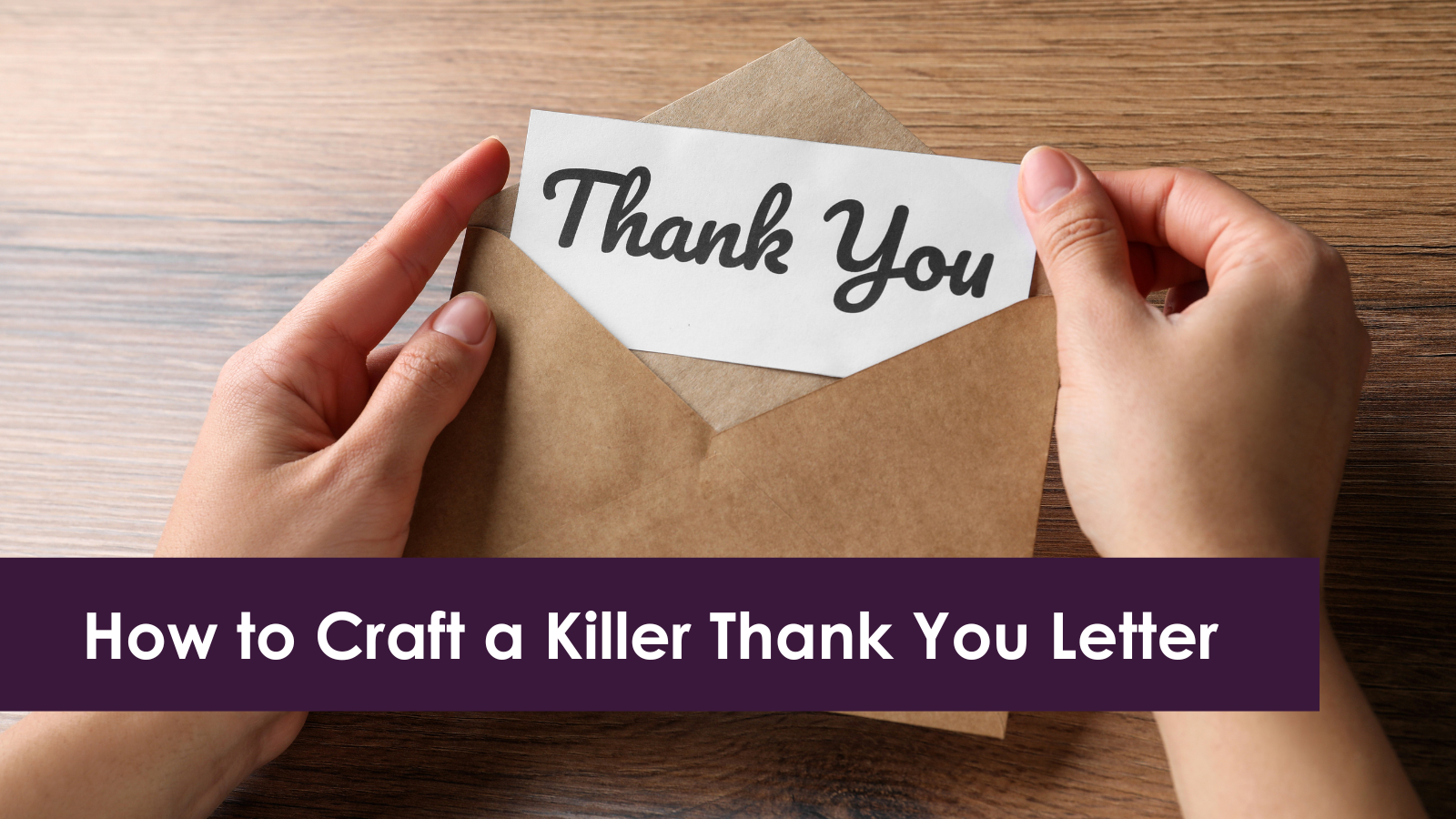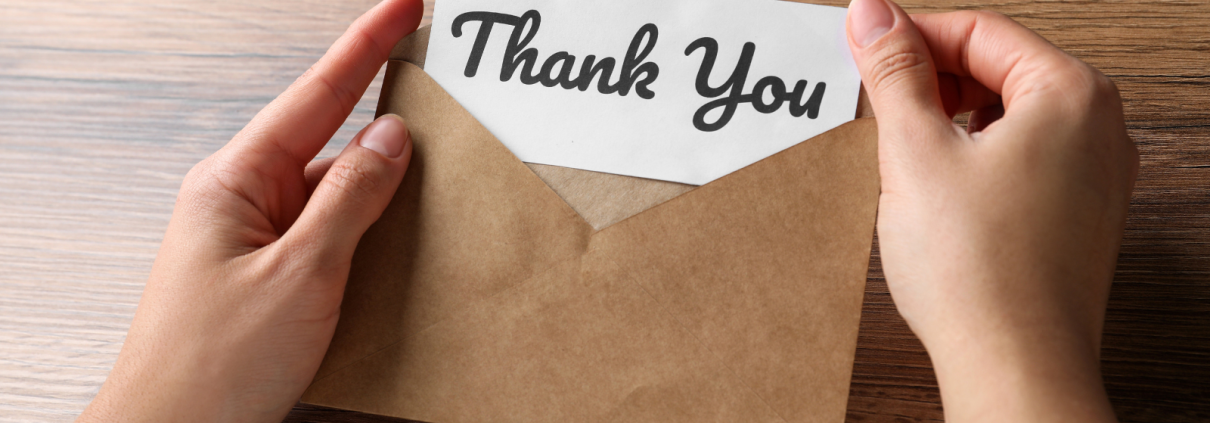How to Write a Killer Thank You Letter

Here’s an important question: Did your last thank you note to a donor make your donor feel:
JOYFUL to know their recent gift made a difference?
ASSURED the gift they made was a wise investment?
PROUD to be supporting such a worthwhile organization?
Remember, a thank you note isn’t just a show of manners. It’s your first step toward retaining this donor for the long run.
Receive expert advice. Direct to your inbox. Subscribe
That’s why feelings are important.
How would you rate your organization’s thank you letters to donors?
Are they warm and gracious? Or do they sound grand and lofty, like someone giving a speech?
We expect your thank you’s can use some brushing up. Invariably, as fundraising consultants, we find that our clients are struggling with lame, tired sounding thank you notes. And they always ask us for help to create a killer thank you letter.
Why are thank you letters so important?
Because this note is your first communication to donors after they give, that’s why. It has the potential to give them confidence, build trust and make them happy that they gave to your cause.
Your letter serves many purposes. It can:
- Assure your nervous donor that they made a wise investment.
- Make your donor feel like they did the right thing.
- Help her feel joyful that they made the gift.
But remember – warm, wonderful thank you letters are essential: It’s the first step in determining whether your donor stays loyal and renews their gift, or if they drop off and never give again.
Today, here’s our checklist of 14 steps to a warm, wonderful, killer thank you letter – one that makes your donor feel confident that they made a wise choice.
1. Make your letter prompt.
A prompt thank you note impresses your donor. They know you made them a priority.
Find out how we can help you achieve your fundraising goals with world-class consulting and custom training.
It also indicates that your organization is well organized and well run. In this day of nervous donors, that gives you a significant leg up the next time you make a request.
2. Make your letter feel personal.
I like Penelope Burk’s suggestions from her landmark book, Donor Centered Fundraising. She lists 20 attributes of a great thank you letter that make it feel special and personal.
So what does personal look like? This makes the letter feel like it came from a real person.
- Use the first person: “I” and “we.”
- Use the second person: “you,” “you” and “you” again. Count how many times you use the word “you.”
- A warm tone toward the donor (vs. a lofty formal, distant tone.)
- Casual writing – use contractions such as “We’ll” rather than “We will.”
- Use an exclamation mark if appropriate.
3. Start out in a personal way.
Start with the salutation.
Say: Dear Ms. Smith. Not: Dear Friend.
Then try to think of a memorable or an unusual opening line. Never begin your letter with, “On behalf of…” You don’t want to lose the reader from the beginning.
4. Use a warm tone.
Does your letter really sound sincere? Or is it full of “nonprofit-speak” with formal words and phrases?
Show yourself as a real person, and try to connect with the donor instead of staying so distant.
5. Be emotional.
Don’t bury it. Giving is an emotional act by the donor. So it’s fine to wear your heart on your sleeve.
Try to convey excitement about what can happen with the donor’s gift.
Say things like:
- “ I can’t begin to thank you enough for . . .”
- “We are absolutely thrilled to have your support again this year.”
- “Because of your gift, a family will . . .”
- “You were wonderful to renew your support . . .”
6. Thank smaller gifts warmly.
Smaller gifts should also get warm, prompt, personal thank you’s.
Remember, there are plenty of major gift prospects in your donor files who are giving you smaller gifts.
Treat these donors well by sending them killer thank you letters that build confidence and trust. Then they may reward you with repeat and larger gifts.
7. Refer to the donor’s past support if you possibly can.
Is your donor a sustaining donor making monthly gifts?
If possible, acknowledge the long term partnership your donor has with your organization.
In fact, celebrate it!
A donor will find it strange and off-putting if they have been giving to you for years and years and you don’t acknowledge it.
8. Sign the letter personally and write a note at the bottom.
You spent all that time writing notes on your appeal letters. By all means, also write a note on the thank you letter.
Remember, the PS is the most-read part of your killer thank you letter. Make it count.
9. Send more than one thank you letter.
The old fundraising motto is: “Find seven ways to thank your donor, and they’ll give again.”
For example, you can always ask different staffers to send an additional note.
This small step could help your organization stand out among a sea of other organizations.
10. Send an additional thank you letter from a board member.
I know organizations that bring stationery to the board meetings and have board members hand-write letters.
We highly recommend this strategy, because it helps connect trustees to the fundraising process.
11. Have a high-ranking person personally sign the letter.
The letter should be signed by the highest ranking person you can find – the chair of the board or a board member. It should not be signed by the wonderful, but lowly, development coordinator.
You could also have the artistic director or a performer sign the letter. Or a teacher if you are a school. Or a field officer if you are an environmental organization.
12. Send an additional thank you letter from a person helped by your organization.
We can’t think of anything more powerful. Your donor is really giving to create an impact, so help them feel this directly.
13. Reconfirm the purpose of the gift.
If the gift is for the library, for example, say something about what the library plans to achieve with the gift.
Most donors are worried that their gift will not be spent wisely.
Acknowledging how the money will be spent is essential – it helps build trust.
14. Include a contact name and number.
Including contact info is good manners, and it makes the donor feel a person connection to your organization.
For example, it would be the head of the library if that’s where the donor directed her gift.
Bottom Line: How to Craft a Killer Thank You Letter
Remember: your overall goal is to keep your donor giving and giving over many years. Your thank you letter is an essential first step in building a long and happy relationship of generous support from your donor.
This is how you create a sustainable fundraising program – developing consistent and repeated gifts from loyal donors who are passionate about your work.
Do’s and Don’ts
Thank you letter DO’s
- Be really, really prompt.
- Get the donor’s name right.
- Have a high-ranking person personally sign the letter.
- Show some emotion.
- Convey gratitude.
- Refer to how the gift will be used.
- Send several thank you notes from different people.
- Include additional thank you letters from board members.
- Send a thank you letter from someone helped by your organization.
- Sign it with a real signature.
- Be positive and upbeat.
- Include a contact name and number if the donor has questions.
- Handwrite it if you know the donor well.
- Begin with an innovative or creative sentence that charms the donor.
Thank You Letter DON’TS
- Start out with “on behalf of.”
- Ask for another gift.
- Use thank you letter jargon: “we are deeply grateful for your continued support.”
- Start out with Dear Friend.
- Ask anything else from your donor right now.
- Misspell their name.
- Have errors in grammar, punctuation or misspellings.
- Go on and on. Ditch the verbosity. Do be concise.
- Keep selling.
- Re-use copy that you used in the solicitation letter to talk about your programs.
- Be formal. Or lofty.
- Be vague about how the money will be used.
- Sign it yourself if you can get a higher-ranking person to sign it.
As always, sharing our weekly news and insights with you is a pleasure.
If your organization is planning a capital campaign – we can help. We’re with our clients every step of the way, inspiring their teams and board, building confidence, driving action and measuring success. Send an email to coaching@gailperry.com if you’d like to schedule a strategy or consulting call with us.



 2024
2024